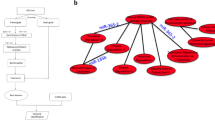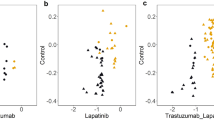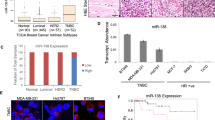Abstract
Metastases, and not the primary tumor from which they originate, are the main reason for mortality from carcinoma. Although the molecular mechanisms behind metastasis are poorly understood, it is clear that epigenetic dysregulation at the level of microRNA expression is a key characteristic of the metastatic process that can be exploited for therapy. Here, we describe an miRNA-targeted therapeutic approach for the prevention and arrest of lymph node metastasis. Therapy relies on the inhibition of the pro-metastatic microRNA-10b. It is delivered to primary and lymph node metastatic tumor cells using an imaging-capable nanodrug that is designed to specifically home to these tissues. Treatment of invasive human breast tumor cells (MDA-MB-231) with the nanodrug in vitro downregulates miR-10b and abolishes the invasion and migration of the tumor cells. After intravenous delivery to mice bearing orthotopic MDA-MB-231-luc-D3H2LN tumors, the nanodrug accumulates in the primary tumor and lymph nodes. When treatment is initiated before metastasis to lymph nodes, metastasis is prevented. Treatment after the formation of lymph node metastases arrests the metastatic process without a concomitant effect on primary tumor growth raising the possibility of a context-dependent variation in miR-10b breast oncogenesis.
This is a preview of subscription content, access via your institution
Access options
Subscribe to this journal
Receive 50 print issues and online access
$259.00 per year
only $5.18 per issue
Buy this article
- Purchase on Springer Link
- Instant access to full article PDF
Prices may be subject to local taxes which are calculated during checkout







Similar content being viewed by others

References
Chaffer CL, Weinberg RA . A perspective on cancer cell metastasis. Science 2011; 331: 1559–1564.
Ma L, Teruya-Feldstein J, Weinberg RA . Tumour invasion and metastasis initiated by microRNA-10b in breast cancer. Nature 2007; 449: 682–688.
Ma L, Weinberg RA . Micromanagers of malignancy: role of microRNAs in regulating metastasis. Trends Genet 2008; 24: 448–456.
Ma L, Weinberg RA . MicroRNAs in malignant progression. Cell Cycle 2008; 7: 570–572.
Ma L, Young J, Prabhala H, Pan E, Mestdagh P, Muth D et al. miR-9, a MYC/MYCN-activated microRNA, regulates E-cadherin and cancer metastasis. Nat Cell Biol 2010; 12: 247–256.
Ma L, Reinhardt F, Pan E, Soutschek J, Bhat B, Marcusson EG et al. Therapeutic silencing of miR-10b inhibits metastasis in a mouse mammary tumor model. Nat Biotech 2010; 28: 341–347.
Baffa R, Fassan M, Volinia S, O’Hara B, Liu CG, Palazzo JP et al. MicroRNA expression profiling of human metastatic cancers identifies cancer gene targets. J Pathol 2009; 219: 214–221.
Medarova Z, Pham W, Farrar C, Petkova V, Moore A . In-vivo imaging of siRNA delivery and silencing in tumors. Nat Med 2007; 13: 372–377.
Kumar M, Yigit M, Dai G, Moore A, Medarova Z . Image-guided breast tumor therapy using a small interfering RNA nanodrug. Cancer Res 2010; 70: 7553–7561.
Zhao Y, Bachelier R, Treilleux I, Pujuguet P, Peyruchaud O, Baron R et al. Tumor alphavbeta3 integrin is a therapeutic target for breast cancer bone metastases. Cancer Res 2007; 67: 5821–5830.
Beer AJ, Niemeyer M, Carlsen J, Sarbia M, Nahrig J, Watzlowik P et al. Patterns of alphavbeta3 expression in primary and metastatic human breast cancer as shown by 18F-Galacto-RGD PET. J Nucl Med 2008; 49: 255–259.
Kenny LM, Coombes RC, Oulie I, Contractor KB, Miller M, Spinks TJ et al. Phase I trial of the positron-emitting Arg-Gly-Asp (RGD) peptide radioligand 18F-AH111585 in breast cancer patients. J Nucl Med 2008; 49: 879–886.
Petersen M, Wengel J . LNA: a versatile tool for therapeutics and genomics. Trends Biotechnol 2003; 21: 74–81.
Jepsen JS, Sorensen MD, Wengel J . Locked nucleic acid: a potent nucleic acid analog in therapeutics and biotechnology. Oligonucleotides 2004; 14: 130–146.
Elmen J, Lindow M, Schutz S, Lawrence M, Petri A, Obad S et al. LNA-mediated microRNA silencing in non-human primates. Nature 2008; 452: 896–899.
Weissleder R, Elizondo G, Wittenberg J, Lee AS, Josephson L, Brady TJ . Ultrasmall superparamagnetic iron oxide: an intravenous contrast agent for assessing lymph nodes with MR imaging. Radiology 1990; 175: 494–498.
Nathanson SD, Kwon D, Kapke A, Alford SH, Chitale D . The role of lymph node metastasis in the systemic dissemination of breast cancer. Ann Surg Oncol 2009; 16: 3396–3405.
Medarova Z, Rashkovetsky L, Pantazopoulos P, Moore A . Multiparametric monitoring of tumor response to chemotherapy by noninvasive imaging. Cancer Res 2009; 69: 1182–1189.
Xiang X, Zhuang X, Ju S, Zhang S, Jiang H, Mu J et al. miR-155 promotes macroscopic tumor formation yet inhibits tumor dissemination from mammary fat pads to the lung by preventing EMT. Oncogene 2011; 30: 3440–3453.
Dykxhoorn DM, Wu Y, Xie H, Yu F, Lal A, Petrocca F et al. miR-200 enhances mouse breast cancer cell colonization to form distant metastases. PLoS One 2009; 4: e7181.
Calin GA, Dumitru CD, Shimizu M, Bichi R, Zupo S, Noch E et al. Frequent deletions and down-regulation of micro- RNA genes miR15 and miR16 at 13q14 in chronic lymphocytic leukemia. Proc Natl Acad Sci USA 2002; 99: 15524–15529.
Gabriely G, Teplyuk NM, Krichevsky AM . Context effect: microRNA-10b in cancer cell proliferation, spread and death. Autophagy 2011; 7: 1–3.
Gabriely G, Yi M, Narayan RS, Niers JM, Wurdinger T, Imitola J et al. Human glioma growth is controlled by microRNA-10b. Cancer Res 2011; 71: 3563–3572.
Michel SC, Keller TM, Frohlich JM, Fink D, Caduff R, Seifert B et al. Preoperative breast cancer staging: MR imaging of the axilla with ultrasmall superparamagnetic iron oxide enhancement. Radiology 2002; 225: 527–536.
Harisinghani MG, Barentsz J, Hahn PF, Deserno WM, Tabatabaei S, van de Kaa CH et al. Noninvasive detection of clinically occult lymph-node metastases in prostate cancer. N Engl J Med 2003; 348: 2491–2499.
Medarova Z, Evgenov NV, Dai G, Bonner-Weir S, Moore A . In vivo multimodal imaging of transplanted pancreatic islets. Nat Protocols 2006; 1: 429–435.
Acknowledgements
We thank Pamela Pantazopoulos and Alana Ross for help with the in-vitro, in-vivo and ex-vivo studies and Marytheresa Ifediba for proofreading the manuscript. Confocal microscopy was performed at the Confocal Microscopy Core at MGH with technical assistance from Igor A Bagayev, MS Work at the Martinos Center for Biomedical Imaging was supported in part under Grant R00CA129070 from the National Cancer Institute and a Research Grant from the Breast Cancer Alliance.
Author information
Authors and Affiliations
Corresponding authors
Ethics declarations
Competing interests
The authors declare no conflict of interest.
Additional information
Supplementary Information accompanies the paper on the Oncogene website
Supplementary information
Rights and permissions
About this article
Cite this article
Yigit, M., Ghosh, S., Kumar, M. et al. Context-dependent differences in miR-10b breast oncogenesis can be targeted for the prevention and arrest of lymph node metastasis. Oncogene 32, 1530–1538 (2013). https://doi.org/10.1038/onc.2012.173
Received:
Revised:
Accepted:
Published:
Issue Date:
DOI: https://doi.org/10.1038/onc.2012.173
Keywords
This article is cited by
-
Omniparticle Contrast Agent for Multimodal Imaging: Synthesis and Characterization in an Animal Model
Molecular Imaging and Biology (2023)
-
Recent Research Progress of RGD Peptide–Modified Nanodrug Delivery Systems in Tumor Therapy
International Journal of Peptide Research and Therapeutics (2023)
-
Significance of metastamiR-10b in breast cancer therapeutics
Journal of the Egyptian National Cancer Institute (2022)
-
Radiolabeling and PET–MRI microdosing of the experimental cancer therapeutic, MN-anti-miR10b, demonstrates delivery to metastatic lesions in a murine model of metastatic breast cancer
Cancer Nanotechnology (2021)
-
MiRNA10b-directed nanotherapy effectively targets brain metastases from breast cancer
Scientific Reports (2021)


